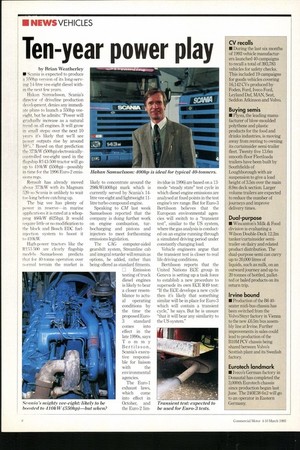Ten-year power play by Brian Weatherley • Scania is expected
Page 10

If you've noticed an error in this article please click here to report it so we can fix it.
to produce a 550hp version of its long-serving 14-litre vee-eight diesel within the next few years.
Ha kan Samuelsson, Scania's director of driveline production development, denies any immediate plans to launch a 550hp veeeight, but he admits: "Power will gradually increase as a natural trend on all engines. It will grow in small steps: over the next 10 years it's likely that we'll see power outputs rise by around 10%." Based on that prediction the 373kW (500hp) electronicallycontrolled vee-eight used in the flagship R143-500 tractor will go up to 410kW (550hp)—possibly in time for the 1996 Euro-2 emissions regs.
Renault has already moved above 373kW with its Magnum 520 so Scania is unlikely to wait too long before catching up.
The big vee has plenty of power in reserve—in marine applications it is rated at a whopping 466kW (625hp). It would require little or no modification to the block and Bosch EDC fuelinjection system to boost it to 410kW.
High-power tractors like the R153-500 are clearly flagship models---Samuelsson predicts that for 40-tonne operation over normal terrain the market is likely to concentrate around the 298kW(400hp) mark which is currently served by Scania's 14litre vee-eight and lightweight 11litre turbo-compound engine.
Speaking to CM last week Samuelsson reported that the company is doing further work on engine combustion, turbocharging and pistons and injectors to meet forthcoming emissions legislation.
3 standard comes into effect in the late 1990s, says Tommy Bertilsson, Scania's executive responsible for liaison with the environmental agencies.
The Euro-1 exhaust laws, which come into effect in October, and the Euro-2 lim its (due in 1996) are based on a 13mode "steady state" test cycle in which diesel engine emissions are analysed at fixed points in the test engine's rev range. But for Euro-3 Bertilsson believes that the European environmental agencies will switch to a "transient test", similar to the US system, where the gas analysis is conducted on an engine running through a simulated driving period under constantly changing load.
Vehicle engineers argue that the transient test is closer to real life driving conditions.
Bertilsson reports that the United Nations ECE group in Geneva is setting up a task force to establish a new procedure to supersede its own ECE R49 test: "If the ECE develops a new cycle then it's likely that something similar will be in place for Euro-3 which will contain a transient cycle," he says. But he is unsure "that it will bear any similarity to the US system."
















































































